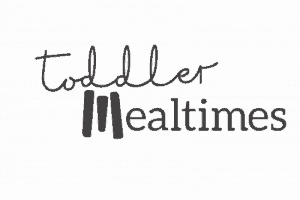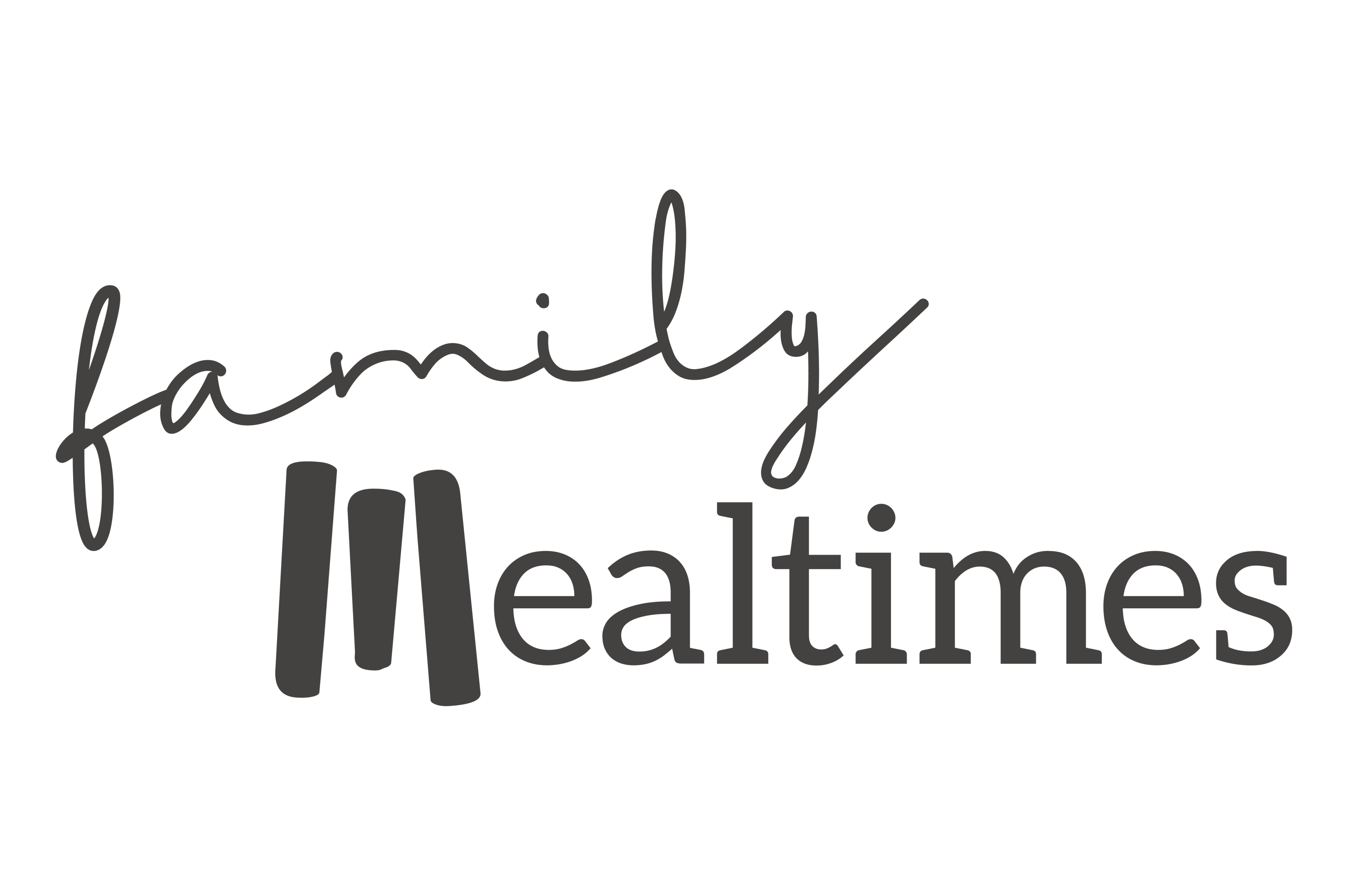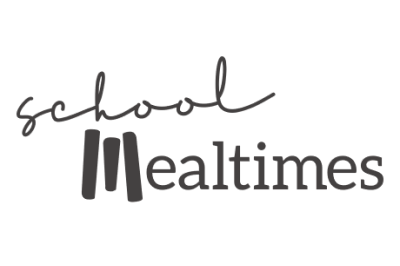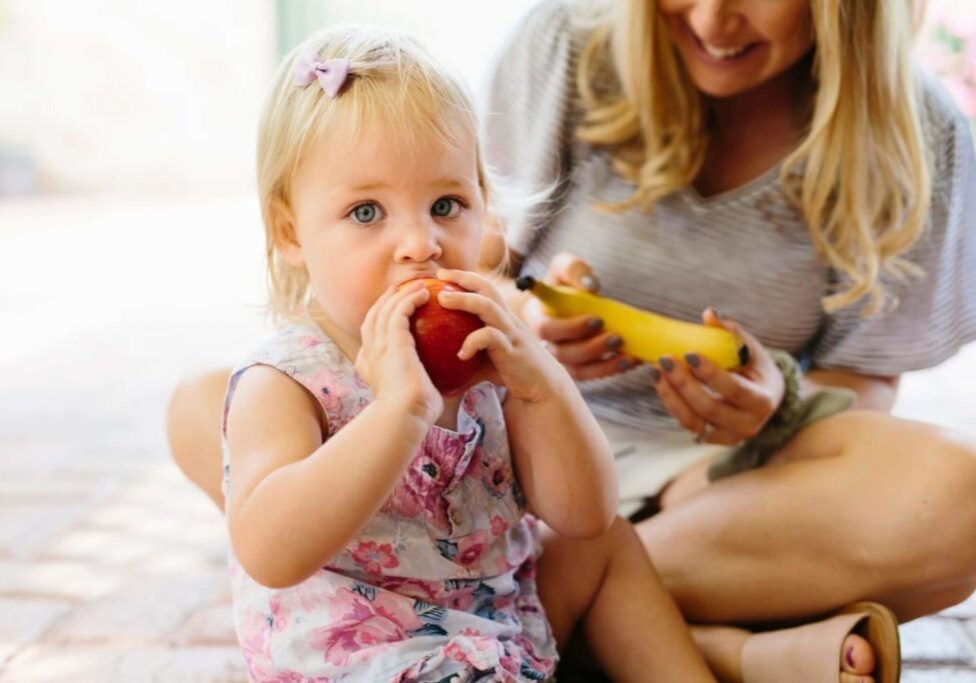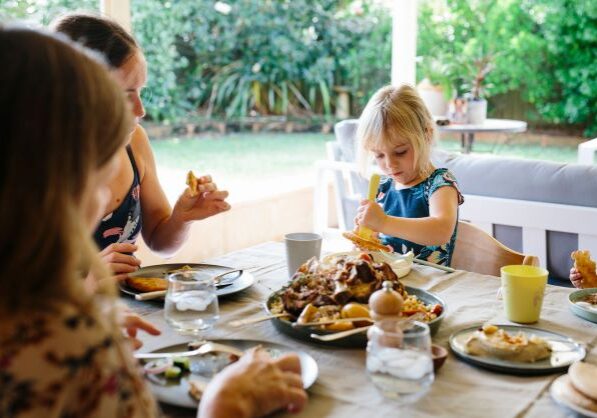School Mealtimes Evidence Summary
Eating at school is a hot topic at the moment, but not something that has traditionally received a lot of attention. There is a reasonable amount of scientific literature available, but very few schools have detailed food policies or the resources to investigate the evidence. In Australia we are far from having a consistent and best-practice approach to mealtimes at school. This has to change.
The following section explains the three most common and concerning food trends we see in schools today.
Each problem includes a summary of the issue, an explanation of the unintended consequences, a summary of the relevant scientific literature and a list of School Mealtimes recommendations.
Problem 1: Children are only allowed fruit and vegetables at recess
This looks like:
- A school or classroom policy where children can only eat fruit and vegetables at recess (this does not include in-class fruit and vegetable breaks).
- Children being prevented from eating other foods from their lunchbox during scheduled meal breaks.
Programs like Crunch&Sip® or ‘Brain Food’ are initiatives designed to increase fruit and vegetable consumption at school, where children are offered an extra opportunity to eat fruit or vegetables during class time. The problem occurs when schools misinterpret the advice of these programs, and insist that children can only eat fruit and vegetables during recess.
Although these rules are well-intended, restricting what a child can eat at recess to only fruit or vegetables can have negative short and long term effects.
Consider these unintended outcomes:
- Children who have natural appetite spikes at mid-morning are not able to access enough food to feel full, despite having other foods in their lunchbox.
- Children may choose to not eat anything at recess time if the fruits or vegetables are spoiled, bruised, mushy, floury, sour or still too unfamiliar to eat.
- Children who struggle to eat fruits and vegetables are unable to access the food that they need, including picky eaters, those with food aversion, sensory processing difficulties, ARFID, diabetes or neurodiversity. This contributes to feelings of judgement and shame around food, along with social exclusion.
- Parents may send disproportionately large amounts of fruits and vegetables to school to make sure their child has enough to feel full. Conversely, parents may send much smaller amounts of fruit or vegetables if their child is required to eat it all.
- Parents are left with large amounts of food waste if their child doesn’t have enough time to eat other foods in their lunchbox.
Parents feel added pressure and stress about providing enough fruits and vegetables in their child’s lunchbox. - Pressuring children to eat fruits and vegetables reinforces the idea that they are better than other foods, like grain, meat and dairy foods. Instead, children need a variety of foods from all food groups.
- Packing fruit and vegetables that will be accepted at school can add unnecessary financial pressure to families.
Evidence
There is no evidence to indicate that limiting what’s available at recess to only fruits and vegetables increases independent fruit and vegetable selection in children. There is however, some evidence to suggest that this approach can have negative consequences. If your school has rules or policies around kids only being able to eat fruit and vegetables at recess, we strongly encourage you to review the evidence for why this may not be appropriate
Be the change School Mealtimes Recommends
Rather than restricting children to only eating fruit and vegetables at recess:
- Trust children to choose what to eat from all the foods provided in their lunchbox at meal and snack breaks.
- This means letting them eat as much as they need to be full, in whatever order they choose.
- If your class participates in Crunch&Sip® or a similar program, do so in addition to recess and lunch, and not as a replacement to these eating opportunities.
- Keep Crunch&Sip® opportunities free from the pressure to eat, remembering that fruit and vegetables may be challenging for some children.
- Never comment on the contents of a child’s lunch box in their presence - More here
In response to the work of School Mealtimes, the Cancer Council of WA have released a statement clarifying that Crunch&Sip® should be an additional activity, and not a replacement for recess or lunch. Read the Crunch&Sip® media statement to address any confusion schools have about the implementation of the program.
Problem 2: Strict rules about how much and what foods children can eat from their lunchbox
This looks like:
- Children who are told they need to eat in a particular order, like having to eat their fruit before other ‘snack’ foods from their lunchbox.
- Children having to save their ‘treat’ foods until they have eaten everything else in their lunchbox.
- Rules around finishing the ‘main’ lunch component (e.g. a sandwich) before being permitted to eat other ‘snack’ foods in a lunchbox.
- Children being required to have “two more bites” of their sandwich or finish everything in their lunch box before they can play.
- Parents asking teachers to monitor children’s food intake, including encouraging them to eat particular foods or not allowing play until a certain amount is eaten.
Although these instructions and rules may be designed to promote healthy eating, dictating the order or amount of food that children must eat from their lunch box can have negative short and long term effects.
Consider these unintended outcomes:
- Children either choose to eat more than they need to get to a desired food, or nothing at all if eating the perceived ‘healthy’ choice seems too difficult or overwhelming. This limits their ability to respect their internal hunger and fullness signals.
- Children who are unable to consume the type or amount of food dictated may miss out on playing with their peers.
- Children may feel ashamed about what’s been provided for them to eat and are anxious about ‘getting into trouble’ about their lunchbox contents at school.
- Children may throw food in the bin before their lunch box is inspected so they can play.
- Children start to internalise messages about food, eating and bodies that reflect beliefs commonly associated with disordered eating practices, for example that food should be earned or that it’s ‘naughty’ to eat certain foods.
- Household conflicts arise between parents and children about what’s appropriate to send in the child’s lunchbox.
- Parents feel confused about what will and won’t be permitted, for example differentiating between banana bread vs. a banana muffin vs. a choc chip banana muffin.
- Teachers are using arbitrary rules to judge the ‘healthfulness’ of foods in the lunchbox, to decide what they will allow children to eat (e.g. is a jam sandwich actually “better” than yoghurt?)
- Parents counter these practices by sending smaller portions of fruits and vegetables that are easier to eat, or less food overall if their child is forced to eat everything in their lunch box before being allowed to play. Some parents have told us that they pack extra food for their child in a ‘secret’ compartment of the cooler bag so their child can access extra food, but only if they wish.
- Parents are less likely to send foods that their child is still learning to like in case the child is forced to eat it, opting instead for a narrower range of familiar choices.
- Teachers feel frustrated and stressed when parents ask them to monitor their child’s eating, or not allow their child to play until they eat all of their food.
- Teachers are burdened by the expectation that they monitor individual children at mealtimes, in addition to their long list of education-related tasks.
Evidence
There is no evidence to indicate that these strategies improve diet quality for children.
Conversely, there is some evidence that applying external pressure or expectations around eating has negative consequences:
School Mealtimes Recommended action
Rather than enforcing strict rules around how much and what foods children can eat from their lunchbox:
- Trust children to eat as much as they need to be full at dedicated eating times.
- This means children do not need to finish a certain amount or type of food to be allowed to play.
- Trust children to eat food from their lunch box in whatever order they choose.
- Refrain from restricting or encouraging particular foods.
- Never comment on the contents of a child’s lunch box in their presence - More here
Problem 3: Children are judged for what they bring to school
This looks like:
- Teachers critiquing lunchbox foods, using terms like ‘red or green’, ‘healthy or unhealthy’, and ‘everyday or sometimes’ foods. This includes in front of children and in notes sent home to parents.
- Children are prevented from eating food packed in their lunchbox if the food is deemed to be a ‘red’ choice. We have heard hundreds of stories of foods being sent home, including leftover birthday cake, muesli bars with choc chips, banana bread, bliss balls, muffins, and yoghurt containing added sugar.
- Children receiving praise or a reward if their lunch box meets the teacher or school’s expectations. Children notice when they have or haven’t received a reward.
- Competitions to have the ‘healthiest’ lunchbox, including sharing photos of children’s lunchboxes to parents.
- Long lists of foods that cannot be sent to school.
- Parents comparing their child’s lunchbox to others and making value judgements based on what they see.
Excessive media coverage on what to put in a lunch box, including arbitrary rules on what is acceptable and what is unacceptable.
Although it seems innocuous to make comments on what a child eats, and often these comments are well-intended, there are a number of potential harmful outcomes that can occur when we try to interfere and pass judgement on a child’s eating.
Consider these unintended outcomes:
- Children struggle to apply concrete thinking to abstract food and nutrition messages, leaving them confused about how to do the ‘right’ thing.
- Children begin to worry about the safety of the food they are provided with, and start to fear that food will cause them harm.
- Children start to become focused on whether it is ‘good’ or ‘healthy’ enough, which makes it difficult for them to learn to like a wide variety of foods over time.
- Children start to internalise messages about food, eating and bodies that reflect beliefs commonly associated with disordered eating practices, for example that food has moral value, and that they should feel bad about eating certain foods.
- Children make choices about food based on feelings of guilt or shame, which is a precursor to disordered eating.
- Children feel left out and disappointed to have not received praise for their lunch box, and are confused about what was ‘wrong’ with their lunchbox.
- Parents feel added pressure and anxiety around providing a lunchbox that will get eaten, that also that meets school recommendations.
- Parents feel the need to compensate for the restrictive food practices at school with extra offers of ‘prohibited’ foods after school and on weekends.
- Teachers feel uncomfortable when school policy and procedures expect them to monitor children's lunchbox content.
- Teachers' resources are further stretched by the burden of monitoring and following up with parents about concerns when they are already stretched by a resource-heavy curriculum.
- Practices cause conflict between teachers who have differing interpretations and values around food and nutrition.
Evidence
In reality there are so many reasons why parents pack certain foods in their child’s lunchbox. We can’t begin to assume what is behind those choices, and passing any kind of judgement without knowing the full picture is problematic.
There are many studies that highlight the complexity behind the choices made for what to include in a child’s lunch box.
This list is by no means exhaustive, but provides an indication of just some of the factors that influence what ends up in a child’s lunchbox. It is also important to acknowledge that school lunches are only a snapshot of what a child eats in a day, let alone in a week or month.
There is no evidence to indicate that labelling foods as ‘good’ or ‘bad’, or commenting on what a child eats improves diet quality, but there is evidence that these practices can have long-term consequences:
School Mealtimes Recommended action
Rather than making judgements about the food children bring to school:
- Trust parents to make decisions around what food they offer their child.
- Avoid commenting on the contents of a child’s lunchbox in their presence. This also includes passing notes to parents via children or using any kind of reward system for ‘healthy’ lunchboxes.
- If you have legitimate concerns about what is being supplied in a child’s lunchbox, consider the challenges faced by the family before deciding whether to raise your concerns with caregivers.
- Is the family facing food insecurity?
- Is the household going through a troubling time?
- Does the child have a medical condition or diagnosis?
- Is the child happily eating from their lunchbox?
- Avoid classifying foods as good and bad, and speak neutrally about food. This means avoiding terms like ‘healthy or everyday’ foods, and ‘unhealthy or sometimes’ foods.
- If you must talk about food, refer to the food by its actual name. A sandwich is a sandwich, a muffin is a muffin, an apple is an apple. There is room for all foods in a healthy diet.
- Consider whether your own biases around food, nutrition and bodies are influencing the way you approach school lunchboxes.
School Mealtimes Frequently Asked Questions
School Mealtimes aims to create safe and empowering school food environments that help school-aged children to become confident, adventurous eaters who have a healthy relationship with food and their bodies. We are working with caregivers, schools, childcare centres and health professionals to identify needs, provide resources and fill gaps, while amplifying the work of existing programs.
School Mealtimes Summary
School Mealtimes calls on parents, teachers and school administration to work together to implement safe food environments in Australian primary schools.
We hope that this evidence can be used to advocate for positive change to help our next generation become confident, adventurous eaters who feel good about their bodies.
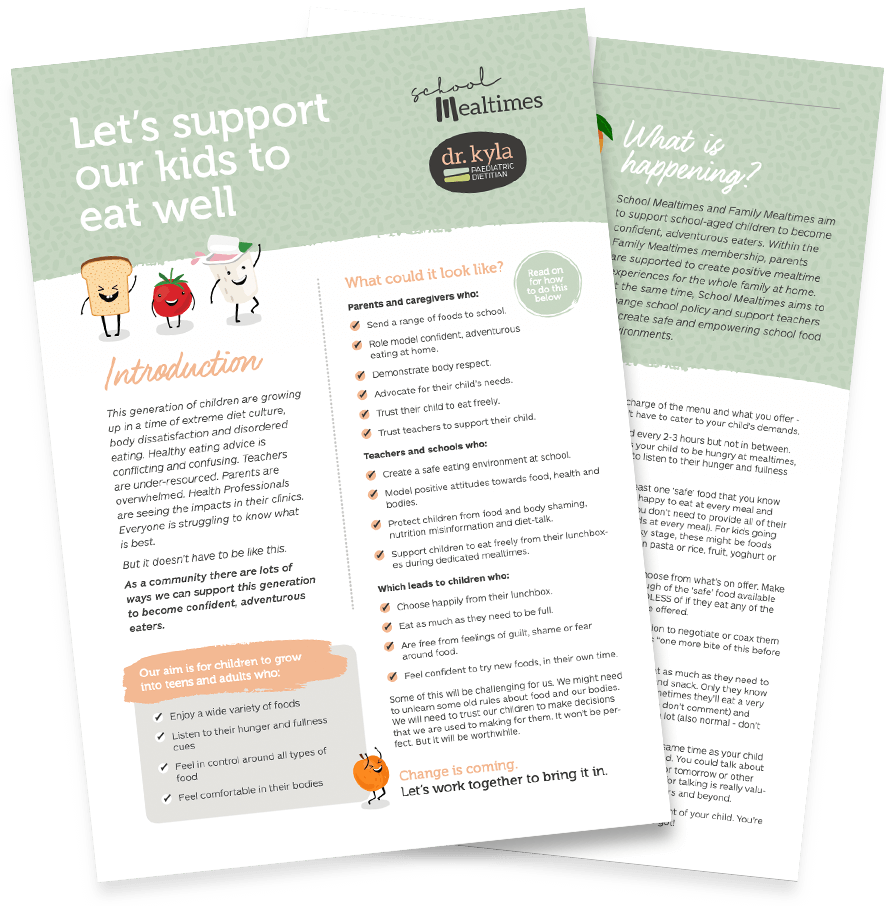
Want some FREE Tools? Enter your email address to download the resource kit
Freebies for parents, teachers, schools and childcare centres:
- Open letter to schools
- Handout for parents
- Normal eating in childhood
- Suggested school policy
- Newsletter graphic
We work with our email distribution platform, ActiveCampaign, to fight spam, and comply with their anti-spam policy.


